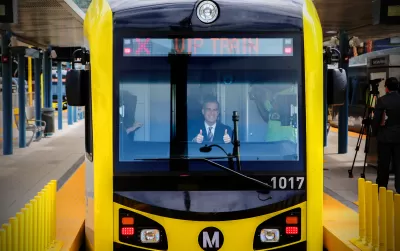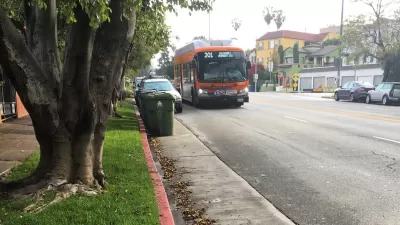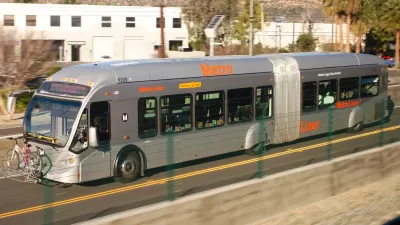Can Los Angeles convince drivers to cut the number of automobile trips in half while also transit frequency on several light rail lines?

Elijah Chiland reported at the end of April on an announcement of a "Green New Deal" by Los Angeles Mayor Eric Garcetti that sets a goal "to reduce the amount of driving in LA by nearly 50 percent in the next three decades."
Right now, LA drivers journey an average of 15 miles per capita per day, according to a report on the initiative released [in April]. That amounts to nearly 60 million miles driven per day within city limits.
Under Garcetti’s proposal, that would come down at least 13 percent by 2025 and 45 percent by 2050—a difference of more than 25 million miles each day, or 6.75 miles per person, should LA’s population stay relatively constant during that time.
Mayor Garcetti intends to achieve these ambitious goals by implementing safety improvements and streetscape projects already underway. Some experts are skeptical the city can achieve these goals, according to Chiland. "Juan Matute, deputy director of the UCLA Institute of Transportation Studies, tells Curbed the mayor’s goals are admirable—but won’t be easy to attain."
In Matute's own words: "Nothing that’s listed here will produce more than a 5 percent reduction […] It probably won’t bring them anything."
The actions of the regional transportation authority are already proving Matute's point about the difficulties of delivering on promises to cut driving. Since that announcement, the Los Angeles County Metropolitan Transportation Authority has decided to cut transit service on several of the region's light rail and high frequency bus lines, as reported in a much more recent article also by Chiland.
Metro’s Board of Directors [recently] approved a proposed $7.2 billion budget for the coming fiscal year, which begins in July. The financial plan includes a nearly 6 percent reduction in rail service hours, with the largest cuts planned on the Expo, Gold, and Blue lines. The change will result in fewer delays, according to Metro.
Chiland also notes that the board's action this week will also cut 75,000 hours of service from Metro's high frequency bus lines.
FULL STORY: Metro will scale back rail service, making for longer wait times

Trump Administration Could Effectively End Housing Voucher Program
Federal officials are eyeing major cuts to the Section 8 program that helps millions of low-income households pay rent.

Planetizen Federal Action Tracker
A weekly monitor of how Trump’s orders and actions are impacting planners and planning in America.

Ken Jennings Launches Transit Web Series
The Jeopardy champ wants you to ride public transit.

California Invests Additional $5M in Electric School Buses
The state wants to electrify all of its school bus fleets by 2035.

Austin Launches $2M Homelessness Prevention Fund
A new grant program from the city’s Homeless Strategy Office will fund rental assistance and supportive services.

Alabama School Forestry Initiative Brings Trees to Schoolyards
Trees can improve physical and mental health for students and commnity members.
Urban Design for Planners 1: Software Tools
This six-course series explores essential urban design concepts using open source software and equips planners with the tools they need to participate fully in the urban design process.
Planning for Universal Design
Learn the tools for implementing Universal Design in planning regulations.
Ada County Highway District
Clanton & Associates, Inc.
Jessamine County Fiscal Court
Institute for Housing and Urban Development Studies (IHS)
City of Grandview
Harvard GSD Executive Education
Toledo-Lucas County Plan Commissions
Salt Lake City
NYU Wagner Graduate School of Public Service





























